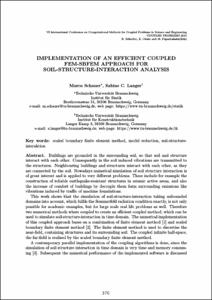Mostra el registre d'ítem simple
Implementation of an efficient coupled fem-sbfem approach for soil-structure-interaction analysis
| dc.contributor.author | Schauer, Marco |
| dc.contributor.author | Langer, Sabine C. |
| dc.date.accessioned | 2020-06-19T09:48:46Z |
| dc.date.available | 2020-06-19T09:48:46Z |
| dc.date.issued | 2015 |
| dc.identifier.isbn | 978-84-943928-3-2 |
| dc.identifier.uri | http://hdl.handle.net/2117/191158 |
| dc.description.abstract | Buildings are grounded in the surrounding soil, so that soil and structure interact with each other. Consequently in the soil induced vibrations are transmitted to the structures. Neighbouring buildings and structures interact with each other, as they are connected by the soil. Nowadays numerical simulation of soil structure interaction is of great interest and is applied to very different problems. These include for example the construction of reliable earthquake-resistant structures in seismic active areas, and also the increase of comfort of buildings by decouple them form surrounding emissions like vibrations induced by traffic of machine foundations. This work shows that the simulation of soil-structure-interaction taking unbounded domains into account, which fulfils the Sommerfeld radiation condition exactly, is not only possible for academic examples, but for large scale real life problems as well. Therefore two numerical methods where coupled to create an efficient coupled method, which can be used to simulate soil-structure-interaction in time domain. The numerical implementation of this coupled approach bases on a combination of finite element method [1] and scaled boundary finite element method [2]. The finite element method is used to discretise the near-field, containing structures and its surrounding soil. The coupled infinite half-space, the far-field is realised by the scaled boundary finite element method. A contemporary parallel implementation of the coupling algorithms is done, since the simulation of soil structure interaction in time domain is very time and memory consuming [3]. Subsequent the numerical performance of the implemented software is discussed in terms of speed-up and efficiency. Different geotechnical applications are illustrated and the applicability of the coupled method is shown and discussed on chosen examples. |
| dc.format.extent | 12 p. |
| dc.language.iso | eng |
| dc.publisher | CIMNE |
| dc.subject | Àrees temàtiques de la UPC::Matemàtiques i estadística::Anàlisi numèrica::Mètodes en elements finits |
| dc.subject.lcsh | Finite element method |
| dc.subject.lcsh | Coupled problems (Complex systems) -- Numerical solutions |
| dc.subject.other | scaled boundary finite element method, model reduction, soil-structureinteraktion |
| dc.title | Implementation of an efficient coupled fem-sbfem approach for soil-structure-interaction analysis |
| dc.type | Conference report |
| dc.subject.lemac | Elements finits, Mètode dels |
| dc.rights.access | Open Access |
| local.citation.contributor | COUPLED VI |
| local.citation.publicationName | COUPLED VI : proceedings of the VI International Conference on Computational Methods for Coupled Problems in Science and Engineering |
| local.citation.startingPage | 370 |
| local.citation.endingPage | 381 |


